ISSN ONLINE(2319-8753)PRINT(2347-6710)
ISSN ONLINE(2319-8753)PRINT(2347-6710)
M.Ravi1, Dr.A.Aruna kumari2, Dr.K.Vijaya Kumar Reddy3
|
| Related article at Pubmed, Scholar Google |
Visit for more related articles at International Journal of Innovative Research in Science, Engineering and Technology
The depletion, increasing demand and price of the petroleum prompted extensive research on biodiesel. There were several studies which indicate the significance of research on biodiesel as a substitute fuel to a diesel fuel. It has shown that biodiesel is one of the promising renewable, alternative and environmentally friendly biofuels that can be used in diesel engine with little or no modifications in the engine. The stringent emission laws, depletion of fossil fuels and relation of fuels with government policies have forced to the world to find alternatives to fossil fuels. Numerous vegetable oils enter have been investigated for use in internal combustion engines. The high viscosity and low volatility of these vegetables oils are the major problem for their use in the diesel engines. However use of different biodiesels in an engine results in variability in the engine performance and emission due to physical and chemical characteristics of fuel. The effect of these physio-chemical properties on fuel supply system such as fuel pump and fuel filter have already been reported. In this work an attempt is made to improve the combustion characteristics of the engine fueled with biodiesel. Hence a detailed investigation is carried out on the Underlying combustion and heat release characteristics. The experimental work is conducted on 4stroke, single cylinder, water cooled and Direct Injection stationary diesel engine. In this work bsfc and thermal efficiency are computed, for different in cylinder pressure and peak heat release rate
Keywords |
| Biodiesel, Fuel Injection Pressure, bsfc, combustion characteristics. |
I. INTRODUCTION |
| India is one of the fastest developing countries with a stable economic growth. Fuel consumption is directly proportionate to the demand [1]. India depends mainly on imported fuels due to lack of fossil fuel reserves and it has a great impact on economy. India has to look for an alternative for alternative fuels in order to sustain the growth rate. Bio-diesel is a promising alternative compared to other alternative fuels for our Diesel needs. With vast vegetation and land availability, certainly bio-diesel is a feasible source of fuel for Indian conditions [2]. Recent studies and research have made it possible to extract bio-diesel at economical costs and quantities. The blend of Bio-diesel with diesel has many benefits like reduction in emissions, increase in efficiency of engine, higher Cetane rating, lower engine wear, low fuel consumption, reduction in oil consumption etc. It can be observed that the efficiency of the engine increases by the utilization of Bio-diesel. Therefore biodiesel will have a great impact on Indian economy [3]. Diesel engine plays a crucial role in the field of power, propulsion and energy. The diesel engine is more efficient than the petrol engine, since the spark –ignition engine consumes more fuel than the compression –ignition engine. The fuel injection system is the most essential component in the working of CI engine [4]. The engine performance, power output, economy etc is greatly dependent on the effectiveness of the fuel injection system. The fuel injection system plays an important role in the combustion process [5]. The fuel injection system in a direct injection diesel engine is to achieve a high degree of atomization for better penetration of fuel in order to utilize the full air charge and to promote the evaporation in a very short time and to achieve higher combustion efficiency [6-8]. A large number of studies have shown that biodiesel is one of the promising renewable, alternative and environmentally friendly bio fuels that can be used in diesel engine [9]. Therefore the objective of this study is to investigate the performance, emissions and combustion characteristics of CI engine running with biodiesel [10]. |
II. MATERIALS AND METHODS |
| In this work we investigated the potential use of Palm Stearin Methyl Ester (PSME) and Animal Tallow Methyl Ester (ATME) as bio-diesels. Brief introductions about the material used in this work are given below. |
Palm Stearin Methyl Ester (PSME) |
| Palm oil is processed into palm olein and palm stearin. Palm stearin is the solid fraction of palm oil that can be Produced by partial crystallization at controlled temperature. It is more variable in composition than palm olein, the liquid fraction of palm oil, especially in terms of its solid fat content, and therefore has more variable physical characteristics. Palm oil with an estimated global (annual) production of 25-27 million tons is the second most produced oil in the world. By country, the leading producers of palm are Malaysia (13 million tons) and Indonesia (10 million tons), and together they have provided about 80% to 90% of the world's palm oil. Also among the various vegetable oils palm oil is the most available one. Palm oil is a vegetable oil which Comes directly from plant seeds and it is mixed with alcohols such as ethanol and methanol by transeterification process from that biodiesel will be produced. Palm stearin methyl ester is used as alternate fuel for diesel engine which is refined from palm oil. |
Animal Tallow Methyl Ester (ATME) |
| Animal Tallow used for production of Biodiesel, Animal Tallow can be used for biodiesel production as easily as Plant Oils. About 14 MT of Tallow is available globally. Tallow as a unique feedstock has certain properties that are hard to reproduce from plant oils. |
| The properties of palm stearin methyl ester, diesel and animal tallow methyl ester are given in following table1. |
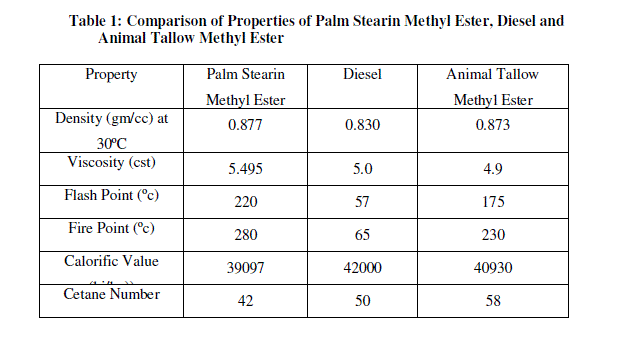 |
III. EXPERIMENTAL WORK |
| The Kirloskar engine is one of the widely used engines in agriculture pump sets, farm machinery and medium scale commercial purposes. The engine specifications are shown in table 2. The setup consists of a single cylinder, four strokes, naturally aspirated, water cooled Diesel engine connected to eddy current dynamometer. This eddy current dynamometer is used for loading the engine. The engine is interfaced with Engine Soft Software for the measurement of combustion parameters. It is provided with necessary instruments for Combustion chamber pressure and crank-angle measurements. For the measurement of cylinder pressure, a pressure transducer is fitted on the engine cylinder head and a crank angle encoder is used for the measurement of crank angle and TDC position. The pressure and crank angle signals are fed to a data acquisition card fitted with Pentium 4 personal computer. The engine speed is sensed and indicated by an inductive pick up sensor in conjunction with a digital rpm indicator, this is a part of eddy current dynamometer. The liquid fuel flow rate is measured on the volumetric basis using a burette and a stopwatch. Provision is also made for interfacing airflow, temperatures and load measurement. The airflow is measured using an orifice meter and the exhaust gas temperatures are recorded with thermocouples. The set up has stand-alone panel box consisting of air box, fuel tank, manometer, fuel measuring unit, Transmitters for air and fuel flow measurements, process indicator and engine indicator. Rotameters are provided for cooling water and calorimeter water flow measurement. A computerized Diesel injection pressure measurement can be conducted through sensor transmitters. The various components of experimental set up are described below.Fig.1 shows line diagram of Experimental setup. |
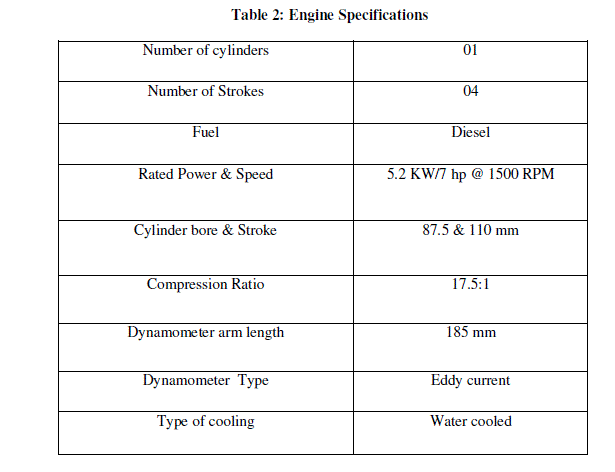 |
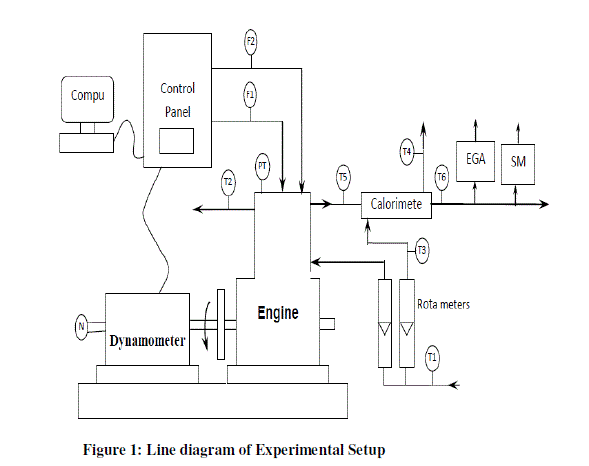 |
IV. RESULTS AND DISCUSSIONS |
| The experiments are conducted for variable loads like 0, 2, 4…up to 16 kg at engine speed of 1500 rpm for Hemispherical type piston and Flat type piston with injection pressures of 180,200,220,240 bar using fuels as Palm Stearin Methyl Ester (PSME), Animal Tallow Methyl Ester (ATME) and also on diesel with normal pressure on 4 stroke, single cylinder, water cooled, diesel engine connected to eddy current dynamometer in Computerized mode in order to study the performance of engine. The performance parameters such as Brake Thermal Efficiency (ηB.Th.), Brake Specific Fuel Consumption (bsfc) and Exhaust Gas Temperature (EGT).Emission parameters such as Carbon Monoxide (CO), Carbon Dioxide (CO2), Un-burnt Hydro carbon (UHC), Nitrogen Oxides (NOx) and oxygen (O2) and also combustion characteristics are evaluated in this project. These engine performances, emission parameters and combustion characteristics of biodiesel are compared to those of pure diesel. |
| The Experimental Discussions for Engine Performance, Emissions Parameters and Combustion Analysis at different injection pressures of 180, 200, 220, 240 bars for Palm Stearin Methyl Ester, Animal Tallow Methyl Ester and Diesel for both Hemispherical and Flat Bowl Piston and the graphs which were drawn below are best at different injection pressures when compared with diesel. |
| Piston1-Hemispherical Type Piston |
| Piston2-Flat Type Piston |
| PSME- Palm Stearin Methyl Ester |
| ATME-Animal Tallow Methyl Ester |
| A. Performance parameters |
| (i). Brake Thermal Efficiency |
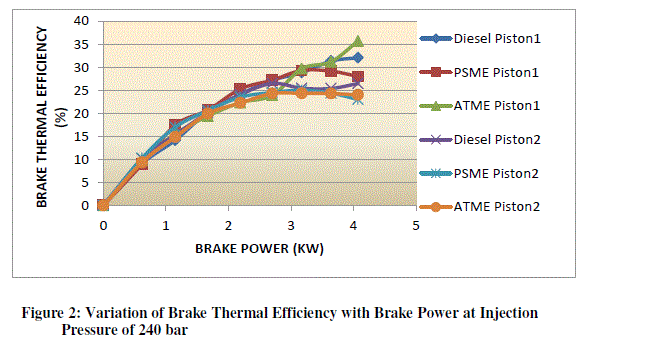 |
| From the figures 2 it is observe that the Brake thermal efficiency for PSME flat piston at injection pressure of 240 bar has lower value of 23% compared to diesel this is due to lower momentum of very fine droplet penetration in combustion chamber and for ATME hemispherical piston has higher value which is 35.67% compared to diesel this is attributed to lower calorific value, lower viscosity coupled with density of fuel. |
(ii). Brake specific fuel consumption |
| From the figure 3 it is notice that the bsfc for ATME hemispherical piston has lower value of 0.245 kg/kw-hr and for PSME flat piston is higher by 49.81% compared to diesel. This observed phenomenon is due to higher viscosity of fuel. |
(iii). Exhaust Gas Temperature |
| From the figure 4 it is examine that Exhaust Gas Temperature for PSME hemispherical piston at a pressure of 200 bar has higher value compared to diesel and for ATME hemispherical piston at pressure of 240 bar has lower value compared to diesel therefore it will have higher performance due to reduction in exhaust heat loss. |
B. Emission Parameters |
| (i).Carbon Monoxide Emissions |
| From the figure 5 it is monitor that CO emissions for ATME flat piston at pressure of 200 bar has lower value and for ATME flat piston at a pressure of 240 bar is higher by 85.99% compared to diesel this is due to incomplete combustion of fuel. |
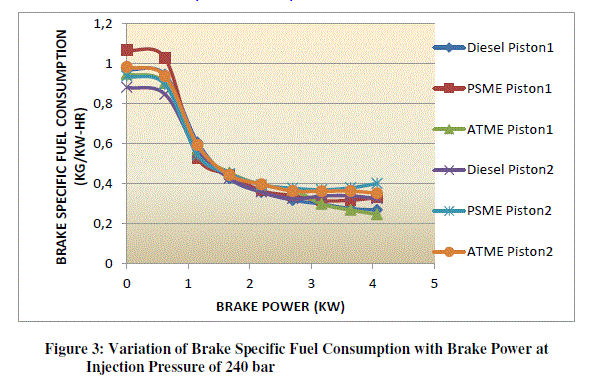 |
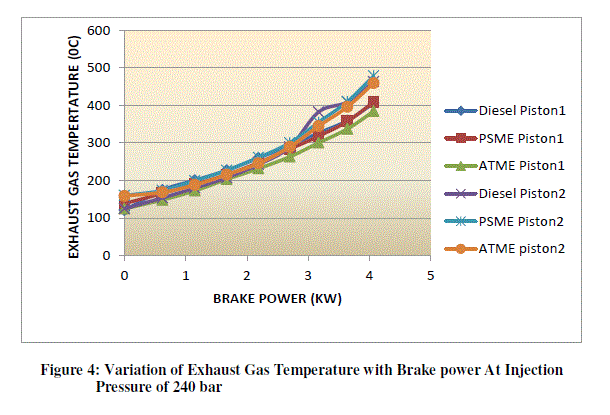 |
(ii).Carbon Dioxide Emissions |
| From the figure 6 it is perceive that PSME flat piston for 220 bar pressure has lower CO2 emissions compared to other fuels and for PSME hemispherical piston at a pressure of 220 bar is higher by 38.21% compared to diesel. This is because of excess supply of oxygen is the influencing criterion. |
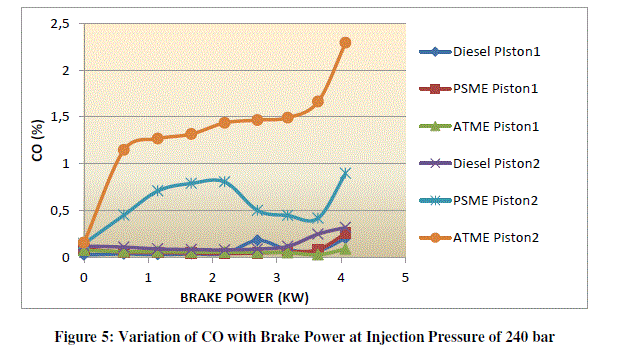 |
(iii). Nitrogen Oxides Emissions |
| From the figure 7 it is inspect that PSME flat piston for 220 bar has lower emissions compared to other fuels at different pressures and for PSME hemispherical piston at rated load is higher by 11.59% compared to diesel. This is attributable to higher peak combustion temperature in the combustion chamber influences this factor.NOX increases for biodiesel compared to diesel this is due to more oxygen content in the combustion chamber. |
(IV). Hydro Carbons Emissions |
| From the figure 8 it is recognize that HC increases at 180 bar for diesel, PSME, ATME for both hemispherical and flat pistons and at 200, 220, 240 bar pressure the HC decreases. So out of these pressures at 220 bar PSME hemispherical piston have fewer emissions. PSME hemispherical piston at 180 bar is lower by 7.67% compared to diesel. This is due to better vaporization and proper atomization. |
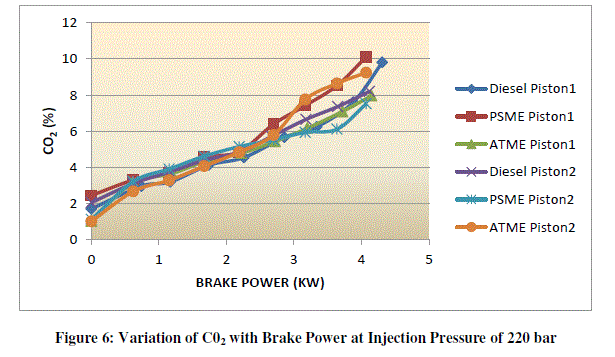 |
C. Combustion Characteristics |
(i). Effect of injection pressure on Combustion characteristics |
| From the figure 9 it is study that the maximum rise of cylinder pressure during combustion near to TDC i.e., 325º-450º crank angle. ATME hemispherical piston at 220 bar pressure is having higher in-cylinder pressure compared to all other fuels at different pressures. The main cause for higher peak in-cylinder pressure in the CI engine running with biodiesel is because of the advanced combustion process initiated by easy flow ability of biodiesel due to physical properties of biodiesel. |
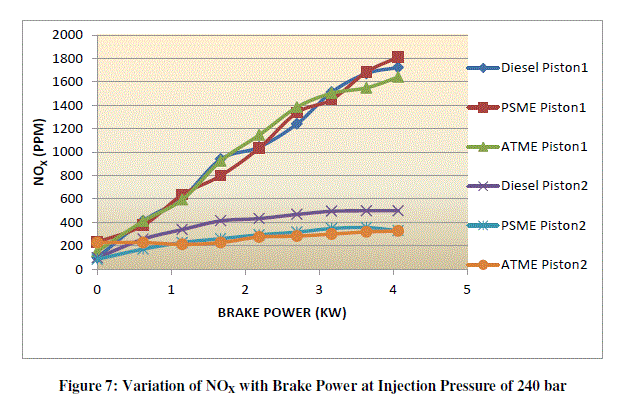 |
V. CONCLUSIONS |
| In this work the experiments are conducted at varied injection pressures using two types of piston geometry. These experiments are conducted using Diesel, Palm Stearin Methyl Ester and Animal Tallow Methyl Ester to evaluate engine performance, emissions and combustion characteristics of CI diesel engine. |
| The conclusions drawn from this work are as follows: |
| • The Brake Specific Fuel Consumption for Palm Stearin Methyl Ester (PSME) for Hemispherical and Flat bowl Pistons at Injection pressures of 180, 200, 220, 240 bar is higher than that of diesel. The PSME for Flat bowl piston at injection pressure of 240 bar is 49.81% higher than that of normal diesel, this is due to higher viscosity. |
| • The Brake Thermal Efficiency for Animal Tallow Methyl Ester (ATME) for hemispherical bowl piston at injection pressure of 240 bar is higher than that of normal diesel. This is because of lower calorific value of fuel, lower viscosity coupled with density of fuel. |
| • The CO emissions for Animal Tallow Methyl Ester (ATME) for Flat bowl piston at Injection pressure of 240 bar at a rated load is higher by 85.99% compared to diesel. This is as a result of incomplete combustion of fuel. |
| • The CO2 emissions for Palm Stearin Methyl Ester (PSME) for Flat bowl piston at injection pressure of 240 bar at a rated load is higher by 5.95% compared to diesel. The oxygen % is more in the combustion chamber for biodiesel compared to diesel, so there will be better combustion in the combustion chamber. |
| • The NOX emissions for Palm Stearin Methyl Ester (PSME) for Hemispherical bowl Piston for 200 bar at a rated load is higher by 11.59% compared to diesel. This is owing to higher peak combustion temperature in the combustion chamber influences this factor. |
| • The HC emissions for Palm Stearin Methyl Ester (PSME) for hemispherical bowl Piston at 180 bar is lower by 7.67% compared to diesel. |
| • The in-cylinder pressure for Animal Tallow Methyl Ester (ATME) for Hemispherical bowl piston at injection pressure of 220 bar is having higher in-cylinder pressure compared to diesel near to TDC i.e., 325º-450º crank angle. The main cause for higher peak in-cylinder pressure in the CI engine running with biodiesel is attributable to the advanced combustion process initiated by easy flow-ability of bio-diesel due to the physical properties of biodiesel. |
| From the above results, it has been found that performance, Emissions of Palm Stearin Methyl Ester (PSME) and Animal Tallow Methyl Ester (ATME) for both Hemispherical and Flat bowl piston at injection pressure of 240 bar is superior when compared with normal standard diesel. The HC and NOX emissions for PSME and ATME at injection pressure of 180 and 220 bar are superior when compared with diesel. The in-cylinder pressure for ATME for Hemispherical bowl piston at injection pressure of 220 bar is higher compared to diesel. The experimental results also prove that Palm Stearin Methyl Ester (PSME) and Animal Tallow Methyl Ester (ATME) at injection pressure of 240 bar are best alternative fuels for diesel engine. |
ACKNOWLEDGEMENT |
| The authors sincerely thank Department of Mechanical Engineering, JNTU College of Engineering Hyderabad for support, co-operation and encouragement that enabled this experimental work in IC engines. |
References |
|